Optimal Design of Shift Point Strategy for DCT Based on Particle Swarm Optimization
Abstract
:1. Introduction
2. Topic
2.1. The Vehicle Layout
2.2. The Basic Parameters
2.3. Operating Characteristics of Power System
3. Formulation of Shift Law
3.1. Formulation of Power Shift Point Strategy
- is the transmission ratio;
- is the transmission ratio of final drive;
- is the mechanical transmission efficiency;
- is the wheel rolling radius (m).
- is the drag coefficient;
- A is the windward area of vehicles (m2);
- u is the vehicle speed (km/h);
- θ is the slope angle (°);
- δ is the rotating mass conversion factor;
- f is the coefficient of rolling resistance.
- is the wheel moment of inertia (kg m2);
- is the moment of inertia of flywheel (kg m2).
- is the nth gear ;
- is the (n + 1)th gear .
3.2. Establishment of Economical Shift Point
- b is the specific fuel consumption (g/(kW·h));
- is the fuel consumption (mL/s);
- is the engine power (kW·h);
- ρ is the fuel density (kg/L);
- g is the gravity acceleration (m/s2).
3.3. Shift Point Establishment Based on Particle Swarm Optimization
3.3.1. The Establishment of Objective Function
- n is the n gear;
- is the n gear acceleration (m/s2);
- is the gear acceleration (m/s2).
- is the weighting coefficient of dynamic index;
- is the weighting coefficient of economic indicators.
3.3.2. Determination of Optimization Variables
Variable Constraints
3.3.3. Particle Swarm Optimization Solution Application
4. Simulation Results and Analysis
4.1. Establishment of Simulation Verification Model
4.2. Analysis of Economic Validation Results
4.3. Analysis of Dynamic Verification Results
5. Conclusions
Author Contributions
Funding
Institutional Review Board Statement
Informed Consent Statement
Data Availability Statement
Acknowledgments
Conflicts of Interest
References
- Wang, X.; Huang, Y.; Yue, Y.; Li, G. Research on DCT Economic Shift Law of Parallel Hybrid Electric Vehicle. J. Automot. Eng. 2020, 10, 250–262. [Google Scholar]
- Tu, B. Research on Automatic Transmission Control of New 7-Speed Opposed Double Clutch Transmission. Master’s Thesis, Hefei University of Technology, Hefei, China, 2017. [Google Scholar]
- He, N.; Zhao, Z.; Li, Y. Shift regularity and simulation evaluation of double clutch automatic transmission. China Mech. Eng. 2011, 22, 367–373. [Google Scholar]
- Liu, Y. Research on Comprehensive Matching Control of Dual Clutch Automatic Transmission System of Passenger Car. Master’s Thesis, Chongqing University, Chongqing, China, 2010. [Google Scholar]
- Li, J. Shift law analysis and Simulation of double clutch transmission. Master’s Thesis, Hefei University of Technology, Hefei, China, 2012. [Google Scholar]
- Du, C.; Cao, X.; He, B.; Ren, W. Optimum design of parameters of dual clutch transmission based on hybrid particle swarm optimization. J. Jilin Univ. 2020, 50, 1556–1564. [Google Scholar]
- Deng, H. Research on Non-Powered Interrupt Shift Control Strategy for AMT Parallel Hybrid Electric Vehicle. Master’s Thesis, Jiangsu University, Zhenjiang, China, 2019. [Google Scholar]
- Yu, J.; Wu, C.; Hu, Y.; Mou, J. Characteristic analysis of new hybrid hydro mechanical composite transmission. J. Jiangsu Univ. Nat. Sci. Ed. 2016, 37, 507–511. [Google Scholar]
- Zhou, S.; Walker, P.; Wu, J.; Zhang, N. Power on gear shift control strategy design for a parallel hydraulic hybrid vehicle. Mech. Syst. Signal Process. 2021, 159, 107798. [Google Scholar]
- Tang, P.; Mao, Z.; Cai, Z. Research on Economic Shift Rule of Electric Vehicle Using Immune Particle Swarm Optimization. J. Chongqing Univ. Technol. 2021, 35, 67–74, 144. [Google Scholar]
- Luna, G.L.; Qu, J.; Guo, Z.; Mi, J.; Zhao, Z. Research on Comprehensive Shift Rule of TBW Automotive Based on Particle Swarm Optimization. J. Guangxi Univ. 2019, 44, 647–656. [Google Scholar]
- Liu, D. Research on Shift Rule of Full-Electricity AMT. Master’s Thesis, Central South University of Forestry Science and Technology, Changsha, China, 2015. [Google Scholar]
- Zhan, C.; Wang, Q.; Zhu, D.; Sui, H. AMT Shift Rule Design of Hybrid Electric Vehicle Based on Intelligent Optimization. Eng. 2020, 36, 110–116. [Google Scholar]
- Hou, R.; Zhang, J.; Lin, C. New Approach of Comprehensive Shift Schedule Based on Electric Drive Automated Mechanical Transmission. Energy Procedia 2016, 88, 945–949. [Google Scholar]
- Li, H.; He, H.; Peng, J.; Li, Z. Three-parameter Shift Schedule of Automatic Mechanical Transmission for Electric Bus. Energy Procedia 2018, 145, 504–509. [Google Scholar]
- Wang, J.; Liu, Y.; Liu, Q.; Xu, X. Power-based Shift Schedule for Pure Electric Vehicle with a Two-speed Automatic Transmission. IOP Conf. Ser. Mater. Sci. Eng. 2016, 157, 012016. [Google Scholar]
- Tian, F. 8AT Automatic Transmission Transmission Ratio Calculation and Shift Law Research and Simulation. Master’s Thesis, Northeast Forestry University, Harbin, China, 2020. [Google Scholar]
- Ruan, J.; Walker, P.; Zhang, N. A comparative study energy consumption and costs of battery electric vehicle transmissions. Appl. Energy 2016, 165, 119–134. [Google Scholar]
- Nguyen, C.T.; Walker, P.D.; Zhang, N. Shifting strategy and energy management of a two-motor drive powertrain for extended-range electric buses. Mech. Mach. Theory 2020, 153, 103966. [Google Scholar]
- Lin, C.; Zhao, M.; Pan, H.; Yi, J. Blending gear shift strategy design and comparison study for a battery electric city bus with AMT. Energy 2019, 185, 1–14. [Google Scholar]
- Guo, L.; Li, G.; Gao, B.; Chen, H. Shift Schedule Optimization of 2-Speed Electric Vehicle Using Model Predictive Control. In Proceedings of the 33rd Chinese Control Conference, Nanjing, China, 28–30 July 2014; IEEE: Piscataway, NJ, USA, 2014; Volume 6. [Google Scholar]
- Kennedy, J.; Eberhart, R. Particle swarm optimization. In Proceedings of the ICNN’95 International Conference on Neural Networks, Perth, WA, Australia, 27 November–1 December 1995; IEEE: Piscataway, NJ, USA, 1995. [Google Scholar]
- Sun, W.; Zhang, G.; Liu, L.; Qin, Y.; Zhang, X. Thermal parameter inversion of hydration heat process of concrete box girder based on standard particle swarm optimization algorithm. J. Jiangsu Univ. Nat. Sci. Ed. 2019, 40, 608–613, 620. [Google Scholar]
- Ren, W.; Hao, Z.; Wang, Y.; Xu, J. Application of improved particle swarm optimization algorithm in 3D hydrofoil design. J. Jiangsu Univ. Nat. Sci. Ed. 2017, 38, 168–172. [Google Scholar]
- Wu, X. Research and Application of Multi-objective Particle Swarm Optimization. Master’s Thesis, Nanjing University of Posts and Telecommunications, Nanjing, China, 2016. [Google Scholar]
- Fu, X.; Tie, X.; Liu, H. Energy management of hybrid off-road vehicle based on power demand prediction. J. Jiangsu Univ. Nat. Sci. Ed. 2021, 42, 67–76. [Google Scholar]
- Yu, Z. Automotive Theory; Machine Industry Press: Beijing, China.
- Zhao, S.; Zheng, Q.; Liu, H. Power system matching and Simulation of hybrid logistics vehicle. J. Jiangsu Univ. Nat. Sci. Ed. 2020, 41, 648–654. [Google Scholar]

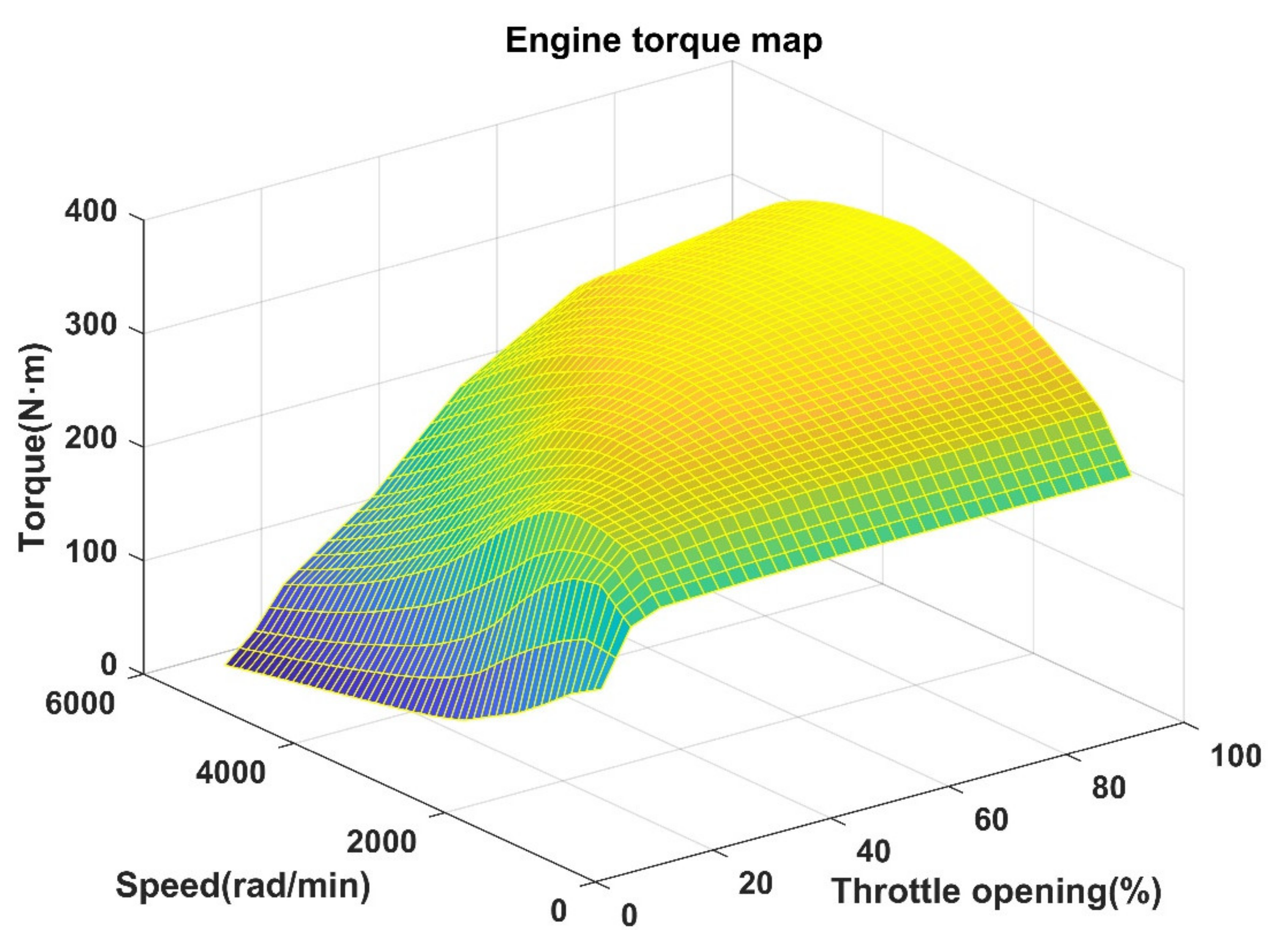

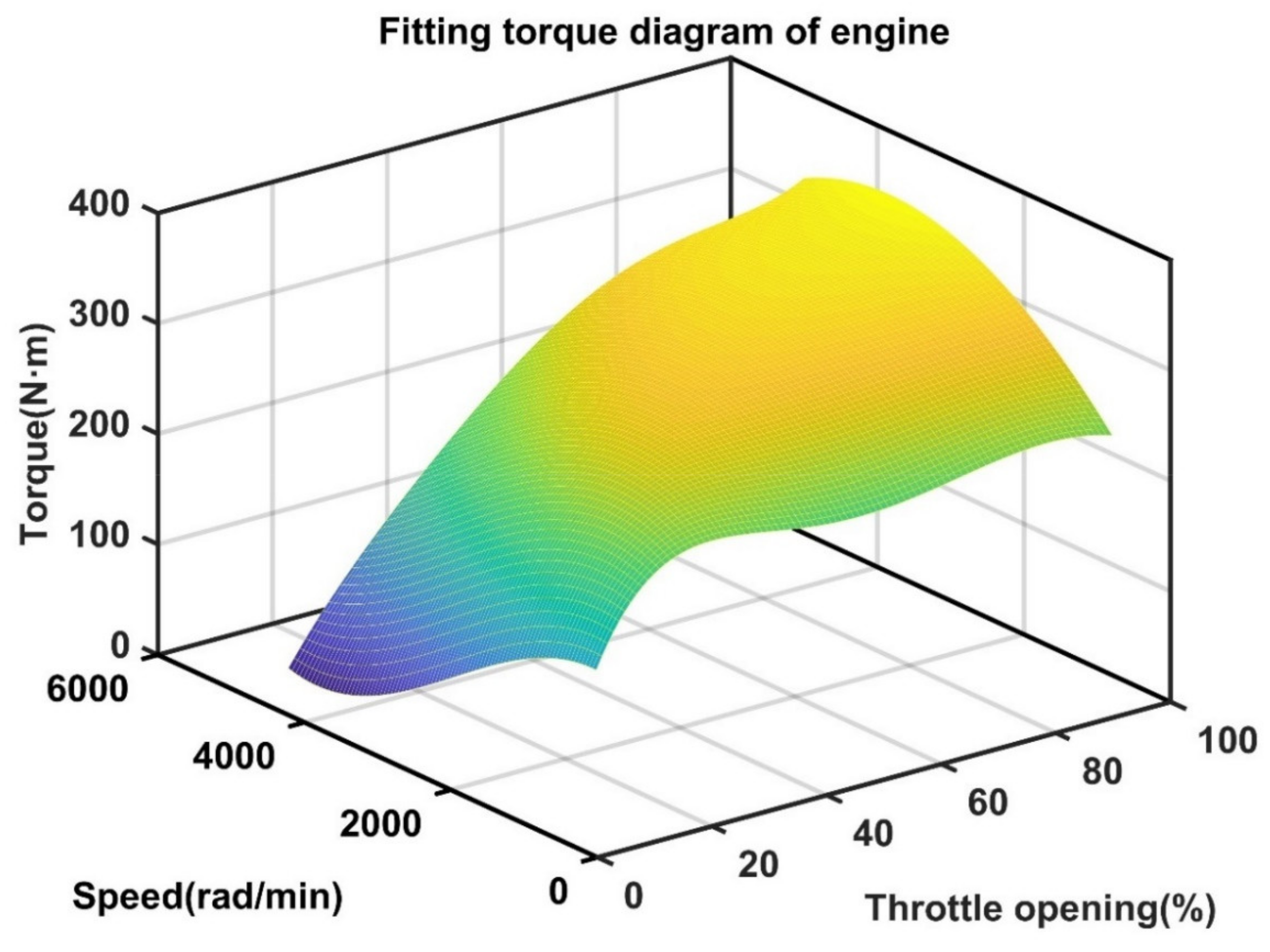
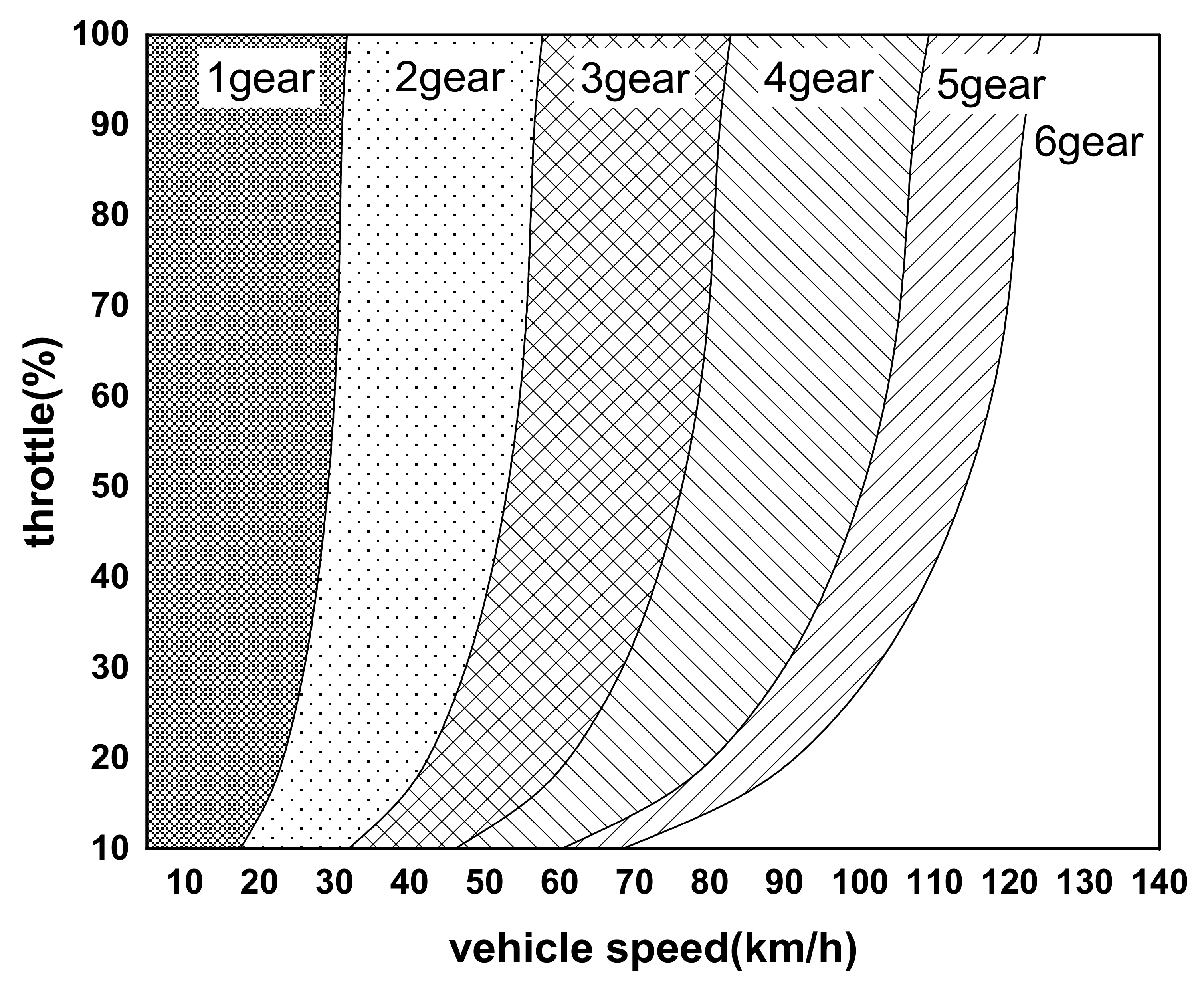
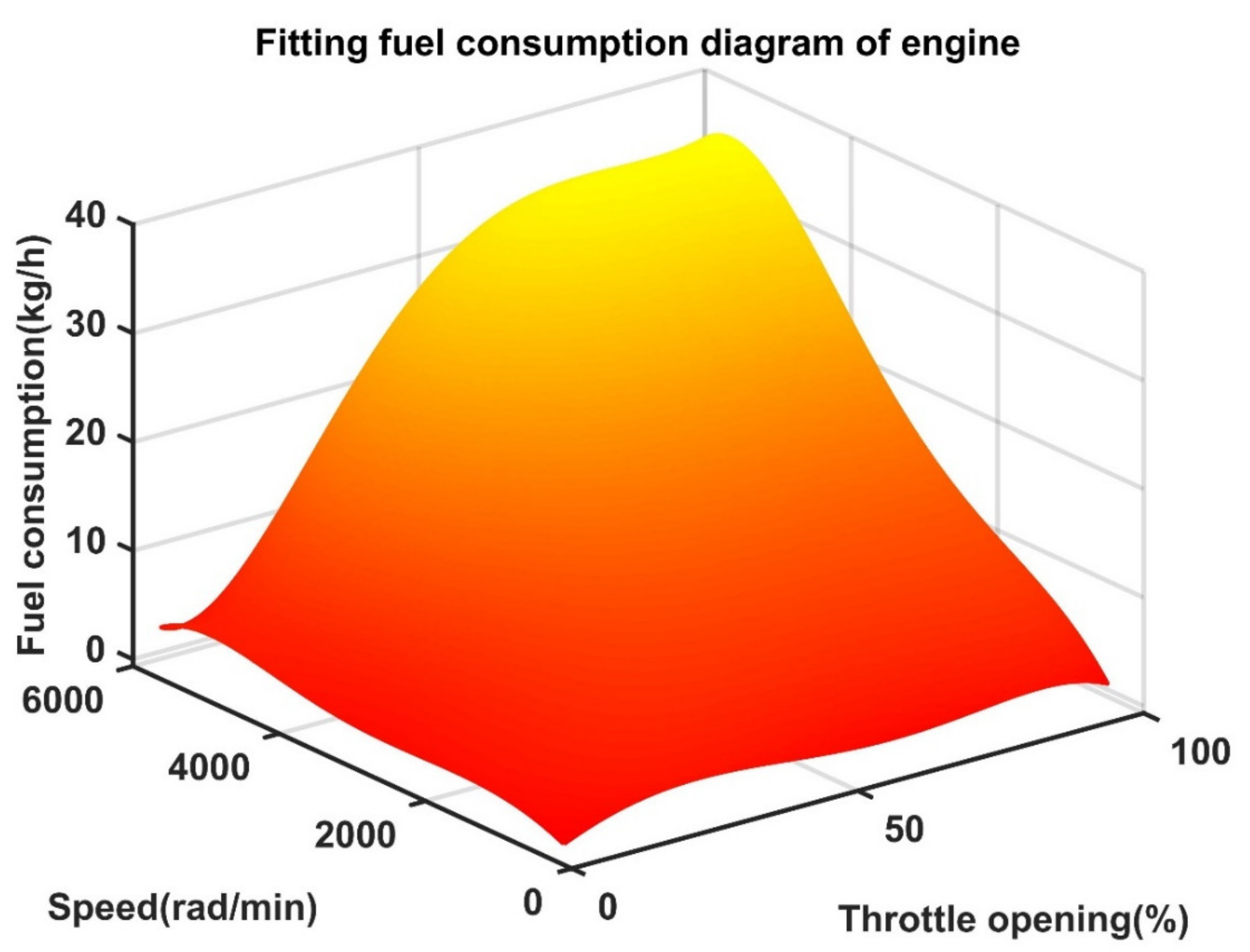

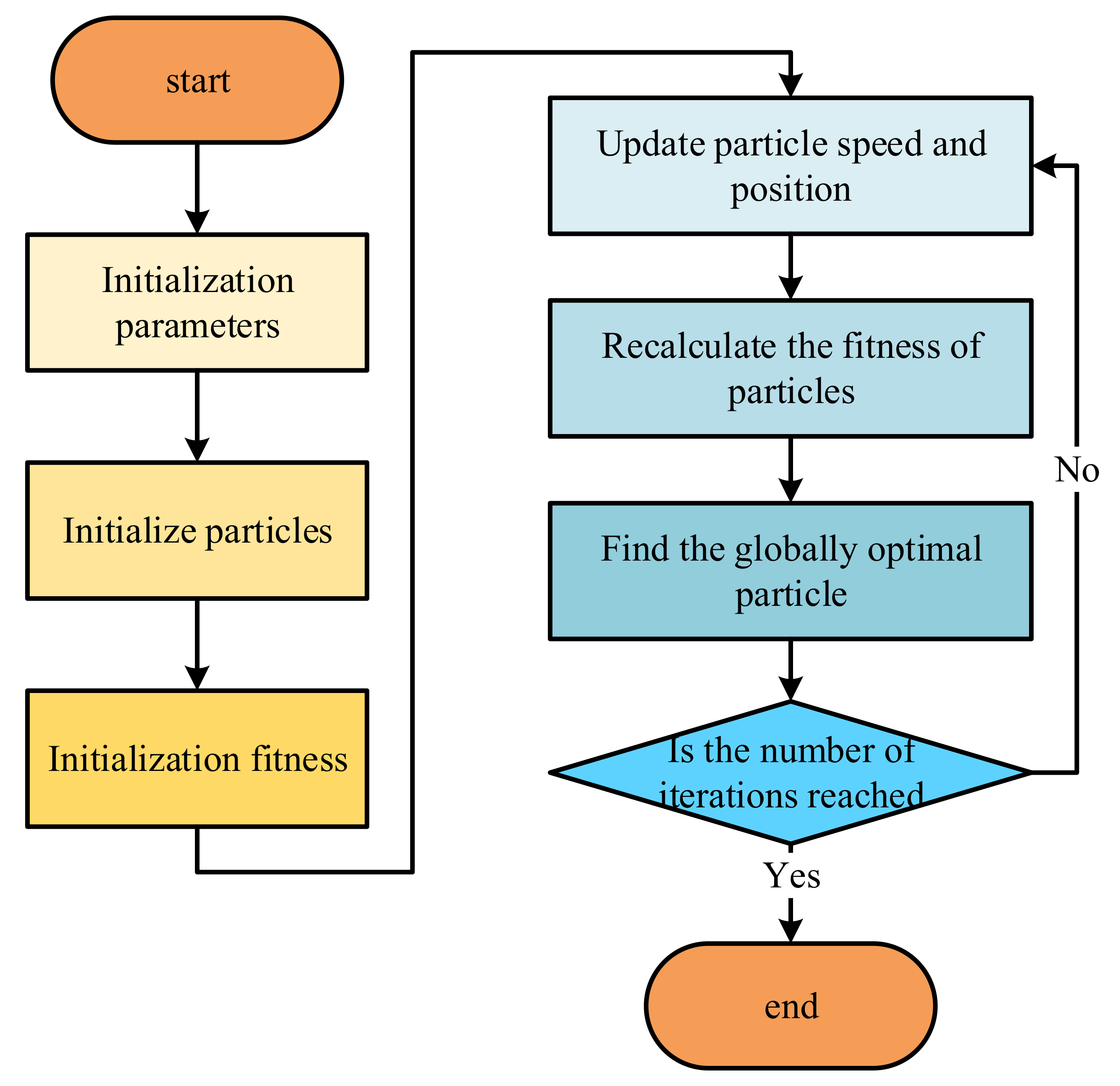
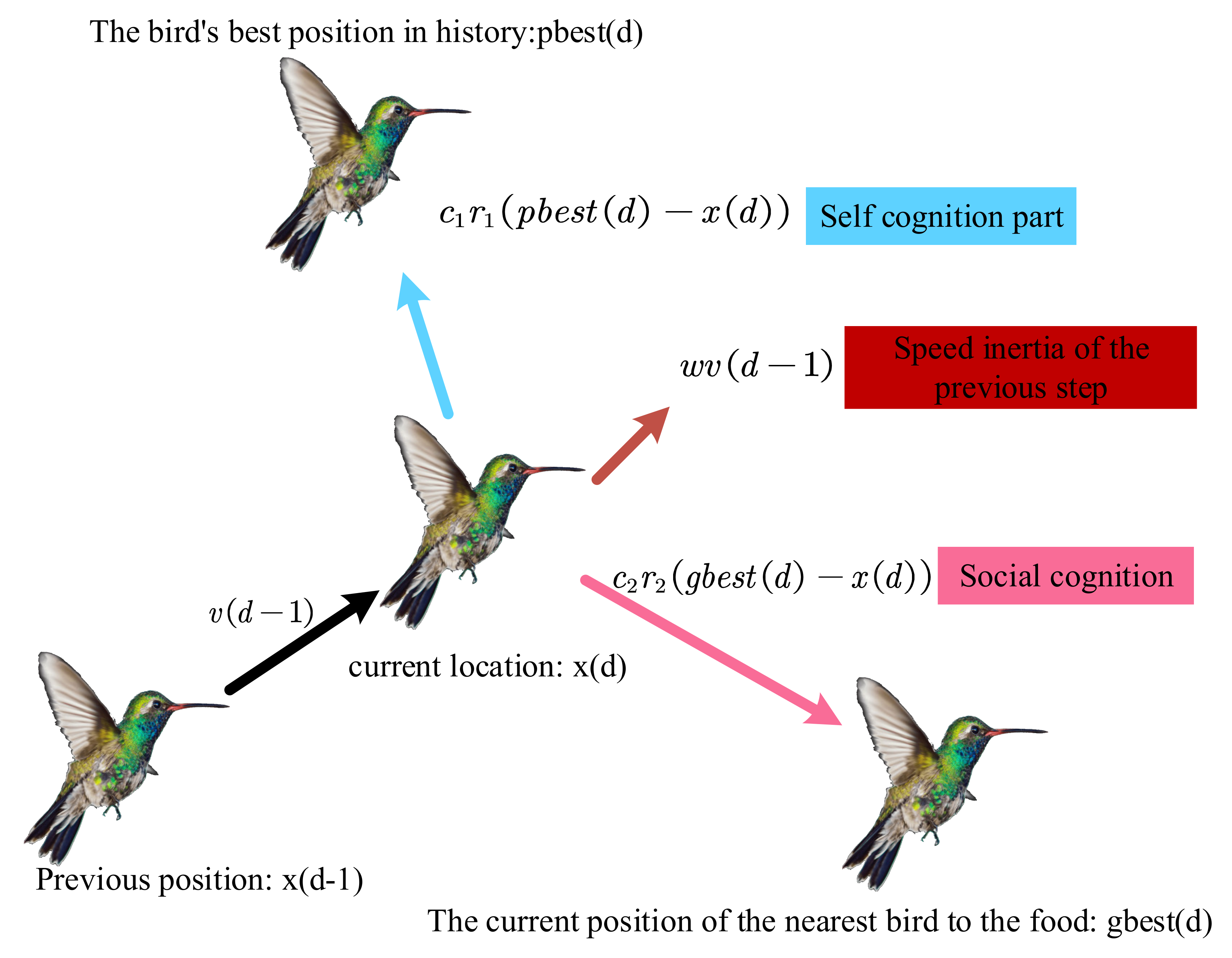

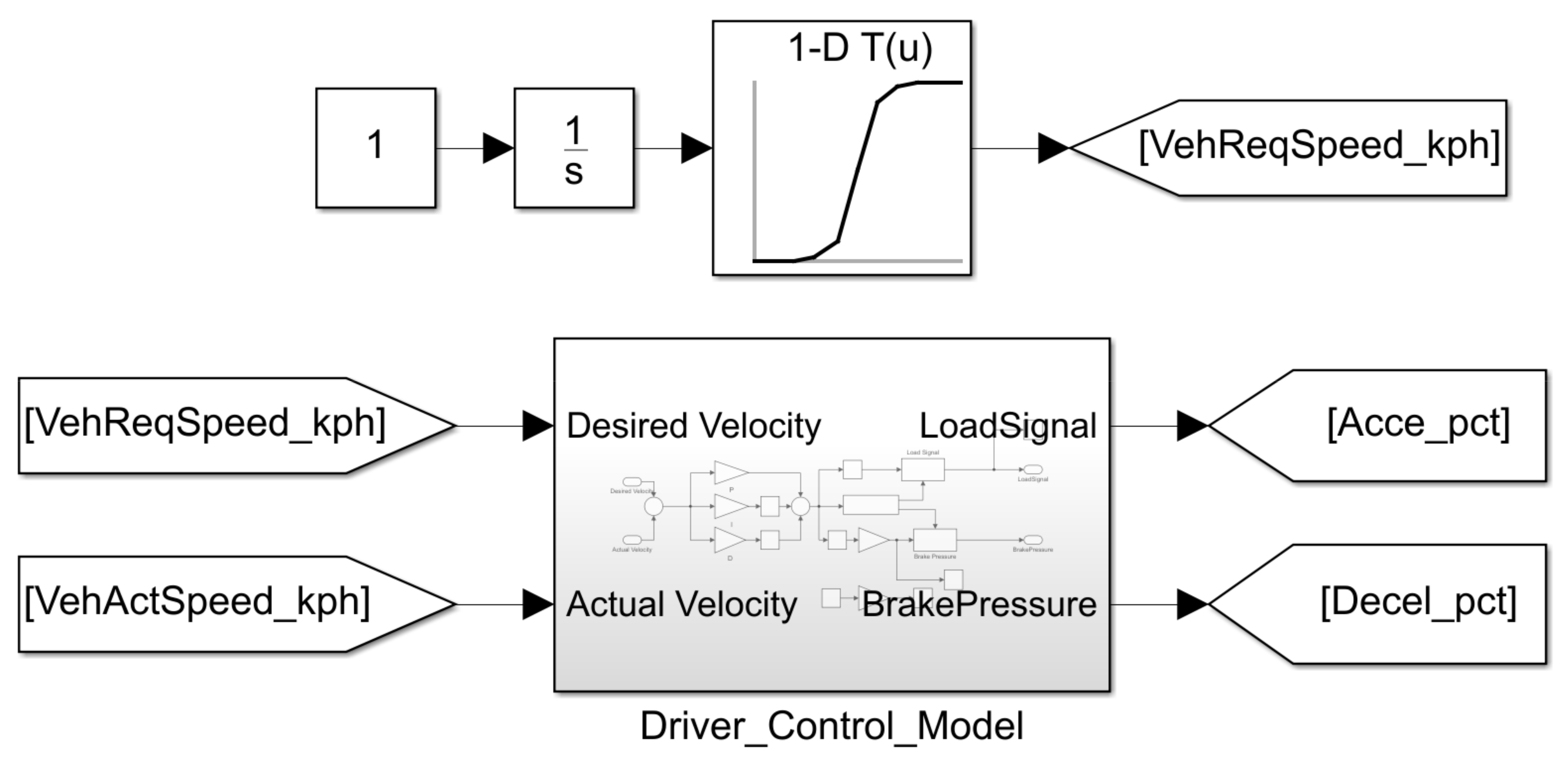

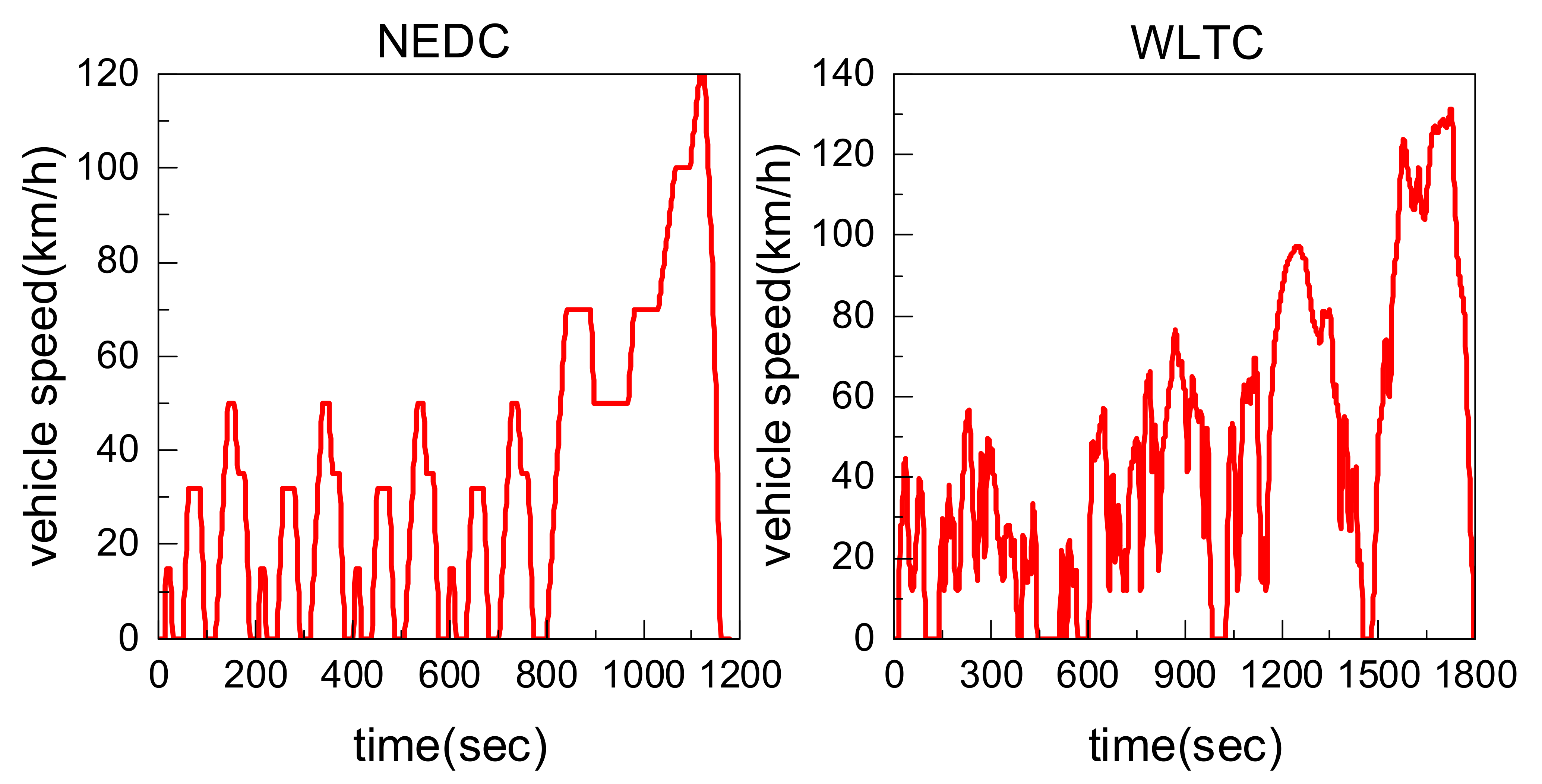


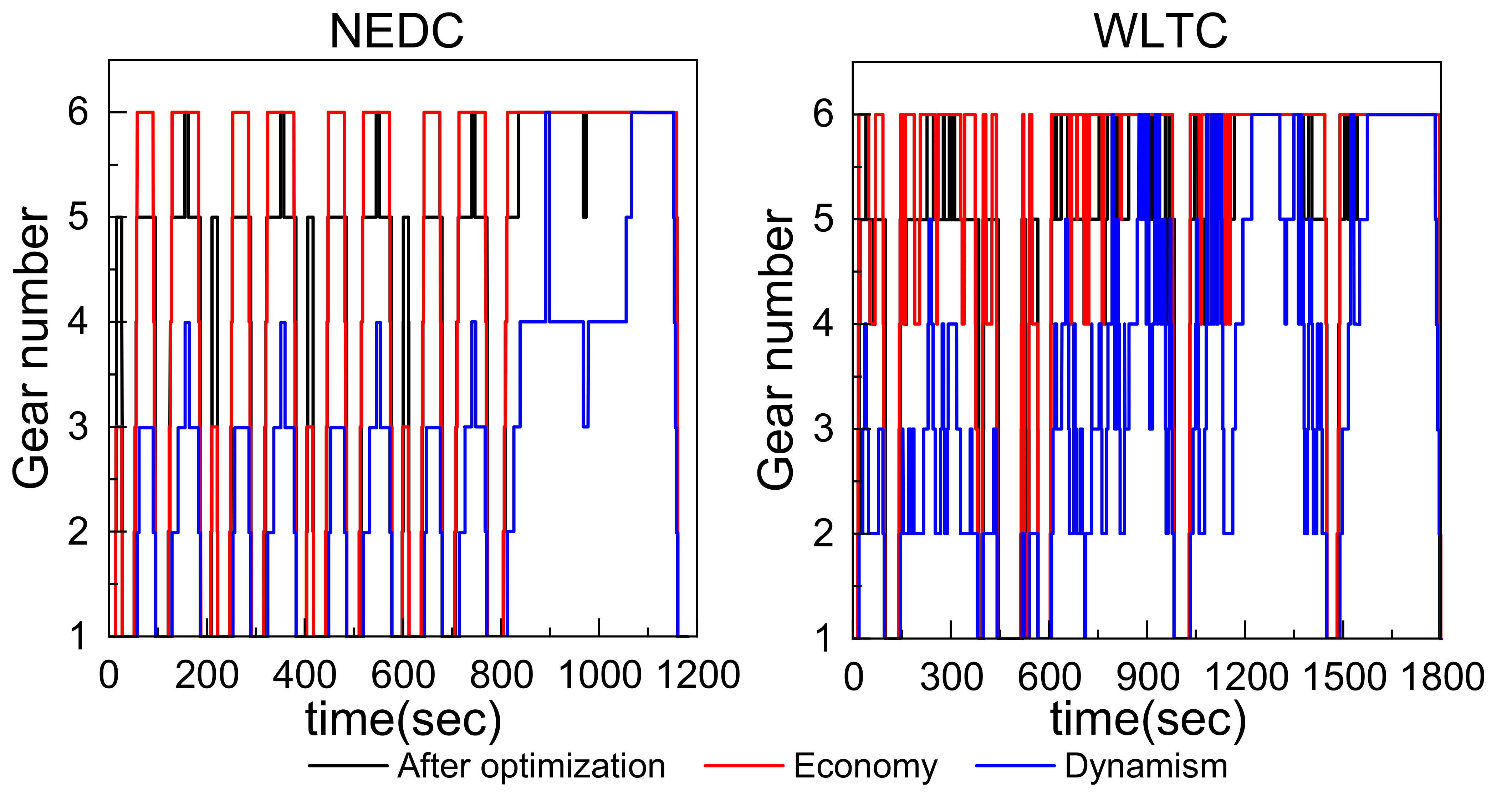
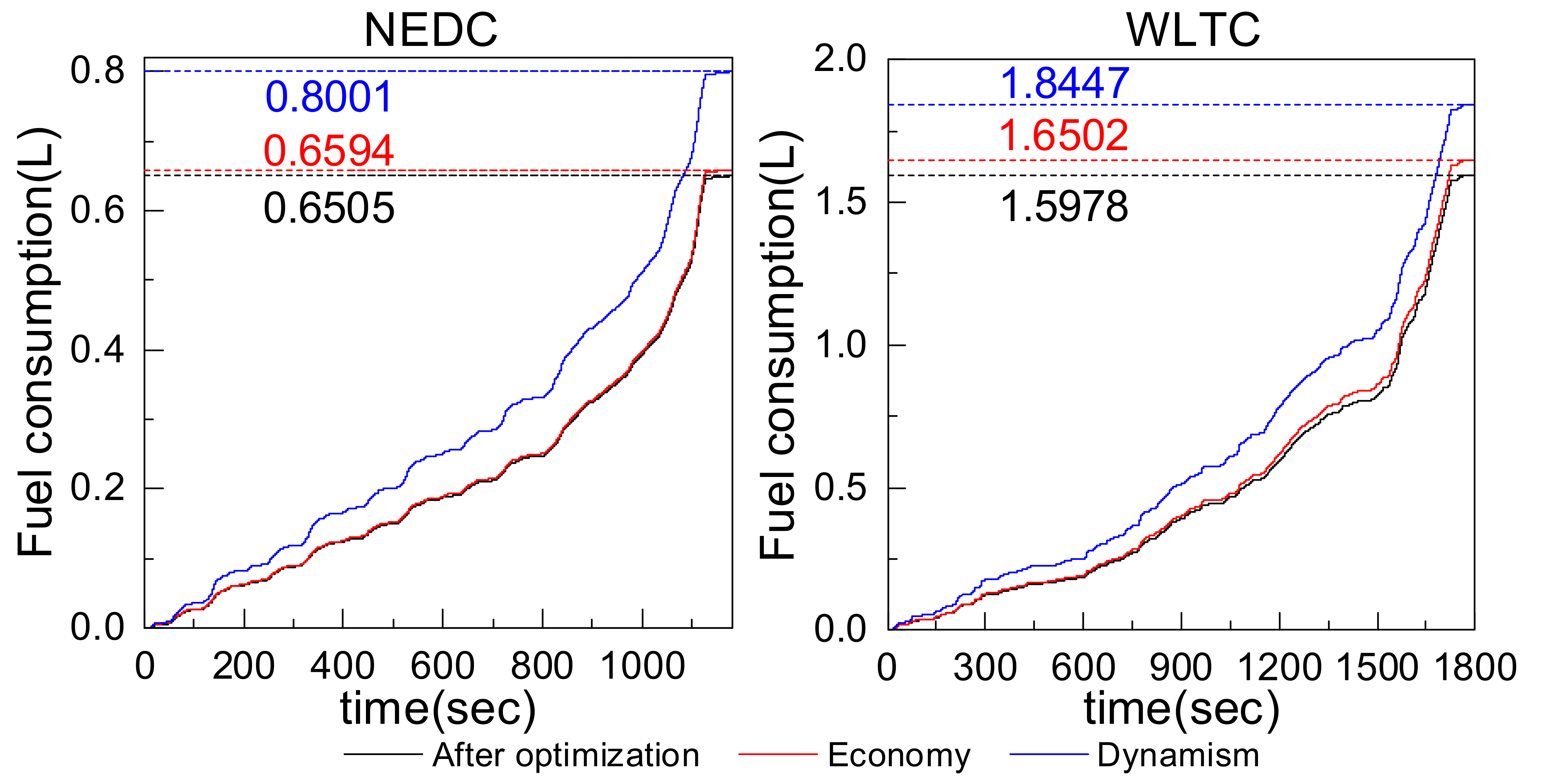
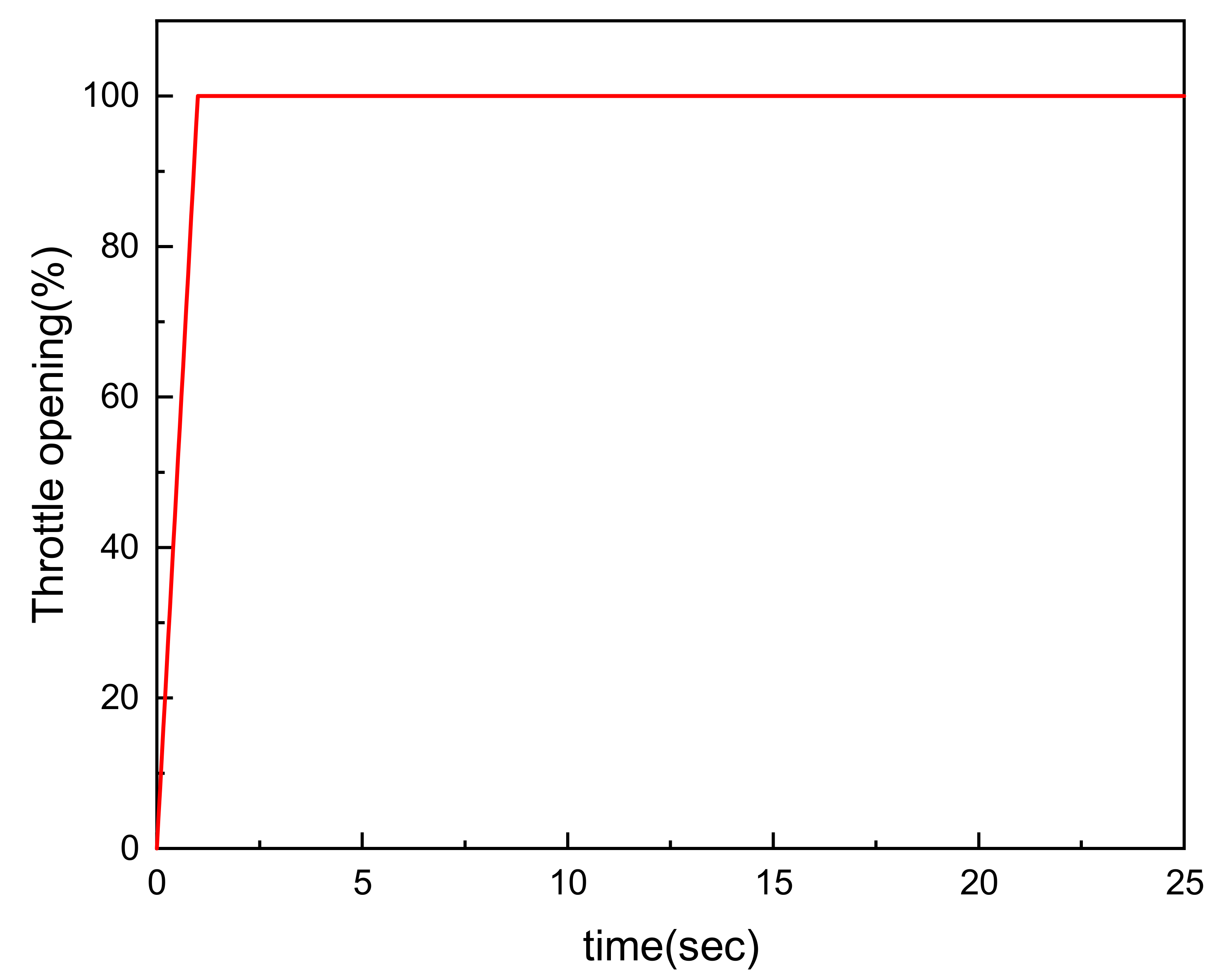


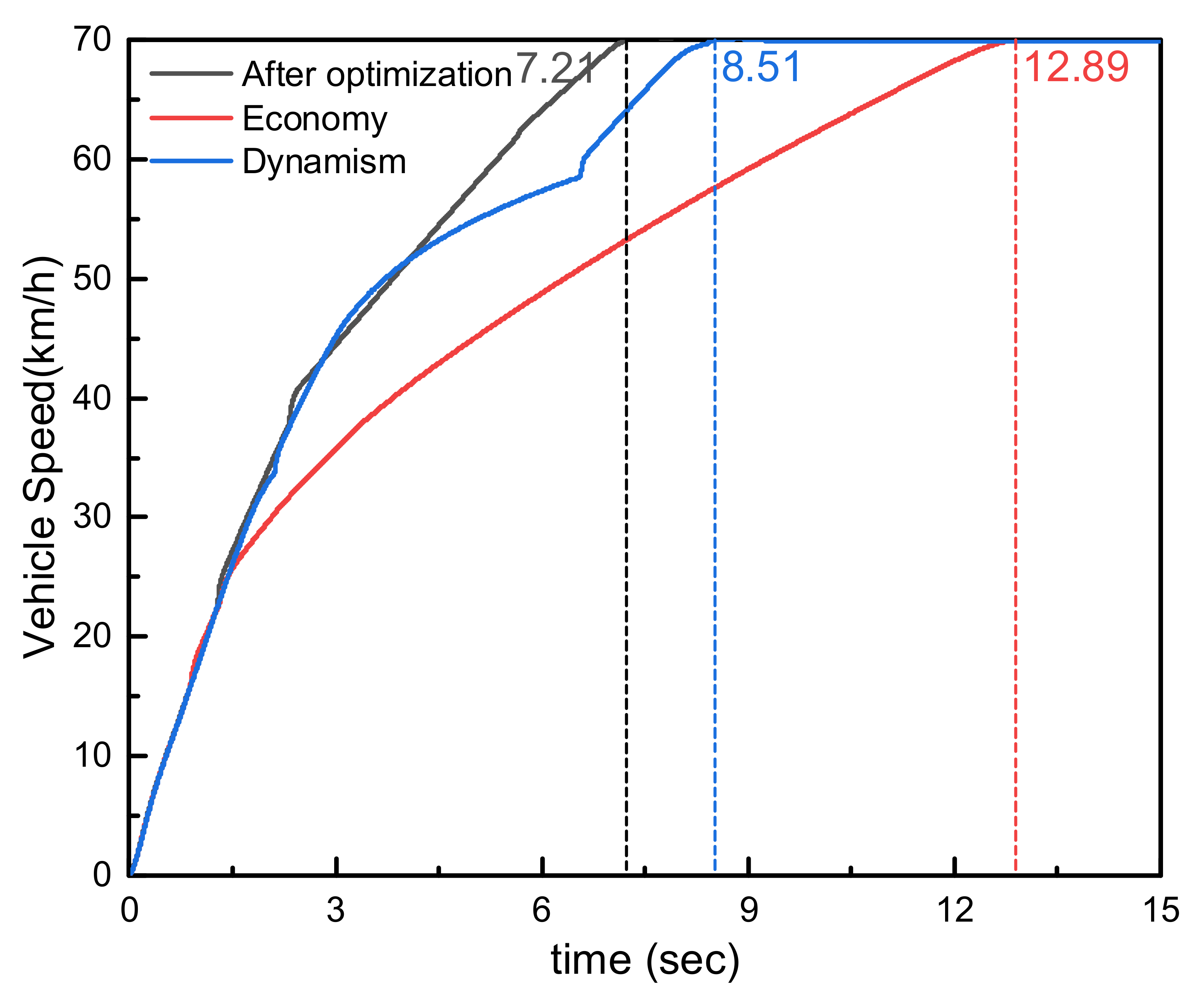

| Type | Name | Index | Units |
|---|---|---|---|
| The vehicle parameters | Weight | 1325 | kg |
| Wheel rolling radius | 0.315 | m | |
| Windward area of vehicles | 1.885 | m2 | |
| Rolling resistance coefficient | 0.015 | 1 | |
| Coefficient of air resistance | 0.36 | 1 | |
| Transmission efficiency | 0.973 | 1 | |
| Ratio of final drive | 3.525 | 1 | |
| Transmission parameter | First gear ratio | 4.83 | 1 |
| Second gear ratio | 3.25 | 1 | |
| Third gear ratio | 1.51 | 1 | |
| Fourth gear ratio | 1.22 | 1 | |
| Fifth gear ratio | 0.885 | 1 | |
| Sixth gear ratio | 0.792 | 1 | |
| Reverse gear ratio | 4.325 | 1 |
| Gear Throttle Opening (%) | 1–2 | 2–3 | 3–4 | 4–5 | 5–6 |
|---|---|---|---|---|---|
| 10 | 17.4568 | 31.9274 | 46.15 | 60.3929 | 68.5103 |
| 15 | 21.101 | 38.721 | 55.95 | 73.378 | 83.28 |
| 20 | 23.391 | 42.89 | 61.9 | 81.28 | 92.2858 |
| 30 | 26.16 | 47.825 | 68.881 | 90.579 | 102.8619 |
| 40 | 27.931 | 50.95 | 73.284 | 96.451 | 109.547 |
| 50 | 29.207 | 53.234 | 76.506 | 100.760 | 114.4549 |
| 60 | 30.08 | 54.844 | 78.787 | 103.822 | 117.947 |
| 70 | 30.581 | 55.792 | 80.139 | 105.649 | 120.0344 |
| 80 | 30.78 | 56.213 | 80.742 | 106.478 | 120.9838 |
| 90 | 30.978 | 56.569 | 81.243 | 107.158 | 121.7612 |
| 100 | 31.66 | 57.752 | 82.903 | 109.352 | 124.2542 |
| Gear Throttle Opening (%) | 1–2 | 2–3 | 3–4 | 4–5 | 5–6 |
|---|---|---|---|---|---|
| 15 | 4.92 | 8.06 | 11.43 | 14.62 | 16.49 |
| 20 | 6.95 | 11.34 | 16.07 | 20.52 | 23.14 |
| 30 | 7.17 | 11.75 | 16.65 | 21.30 | 24.03 |
| 40 | 7.86 | 12.87 | 18.24 | 23.31 | 26.29 |
| 50 | 8.47 | 13.86 | 19.63 | 25.01 | 28.29 |
| 60 | 9.01 | 14.64 | 20.74 | 26.46 | 29.82 |
| 70 | 9.13 | 14.87 | 21.08 | 26.91 | 30.34 |
| 80 | 9.82 | 15.95 | 22.59 | 28.82 | 32.48 |
| 90 | 11.10 | 18.16 | 25.73 | 32.80 | 37.10 |
| 100 | 12.18 | 19.72 | 27.93 | 35.60 | 40.12 |
| Working Condition | NEDC | Reduced Proportion after Optimization | WLTC | Reduced Proportion after Optimization |
|---|---|---|---|---|
| Total fuel consumption of dynamic shift strategy (L) | 0.8001 | 18.70% | 1.8447 | 13.38% |
| Total fuel consumption of economical shift strategy (L) | 0.6594 | 1.37% | 1.6502 | 3.18% |
| Total fuel consumption of optimized shift strategy (L) | 0.6505 | 0.00% | 1.5978 | 0.00% |
| Working Condition | 0–100 km/h | Reduced Proportion after Optimization |
|---|---|---|
| Total time for dynamic shift strategy (s) | 14.68 | 4.087% |
| Total time for economic shift strategy (s) | 24.40 | 42.30% |
| Total optimized shift strategy time (s) | 14.08 | 0.00% |
| Working Condition | 0–70 km/h | Reduced Proportion after Optimization |
|---|---|---|
| Total time for dynamic shift strategy (s) | 8.51 | 15.28% |
| Total time for economic shift strategy (s) | 12.89 | 44.07% |
| Total optimized shift strategy time (s) | 7.21 | 0.00% |
| Working Condition | 70–120 km/h | Reduced Proportion after Optimization |
|---|---|---|
| Total time for dynamic shift strategy (s) | 13.69 | −10.70% |
| Total time for economic shift strategy (s) | 20.58 | 25.51% |
| Total optimized shift strategy time (s) | 15.33 | 0.00% |
Publisher’s Note: MDPI stays neutral with regard to jurisdictional claims in published maps and institutional affiliations. |
© 2021 by the authors. Licensee MDPI, Basel, Switzerland. This article is an open access article distributed under the terms and conditions of the Creative Commons Attribution (CC BY) license (https://creativecommons.org/licenses/by/4.0/).
Share and Cite
Zhang, H.; Yang, X.; Sun, X.; Liang, J. Optimal Design of Shift Point Strategy for DCT Based on Particle Swarm Optimization. Machines 2021, 9, 196. https://doi.org/10.3390/machines9090196
Zhang H, Yang X, Sun X, Liang J. Optimal Design of Shift Point Strategy for DCT Based on Particle Swarm Optimization. Machines. 2021; 9(9):196. https://doi.org/10.3390/machines9090196
Chicago/Turabian StyleZhang, Houzhong, Xiangtian Yang, Xiaoqiang Sun, and Jiasheng Liang. 2021. "Optimal Design of Shift Point Strategy for DCT Based on Particle Swarm Optimization" Machines 9, no. 9: 196. https://doi.org/10.3390/machines9090196






